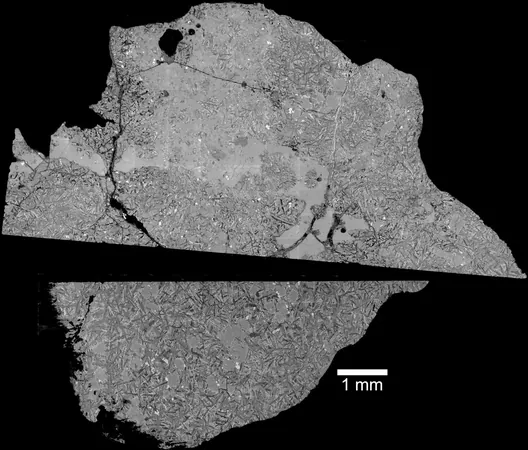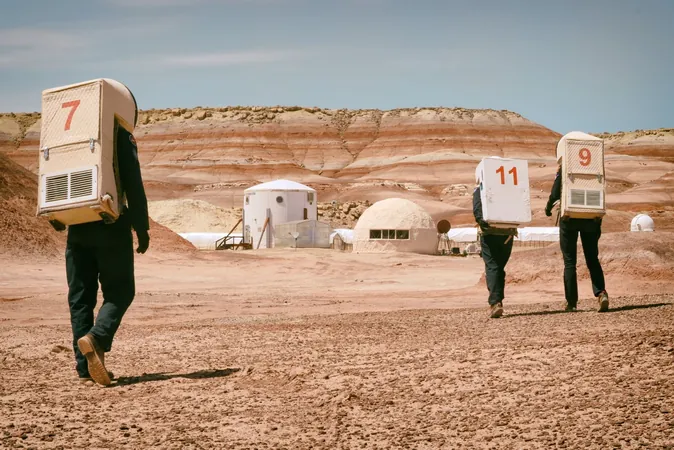
Unveiling the Moon's Secrets: The Youngest Basaltic Lunar Meteorite Transforms Our Understanding of Volcanic Activity
2025-07-08
Author: Charlotte
A Game-Changer in Lunar Research
In a groundbreaking discovery, a meteorite found in Africa in 2023 is shaking up our understanding of the Moon's volcanic history. Estimated to be 2.35 billion years old, this unique basaltic meteorite is filling a significant gap in lunar geology and is now deemed the youngest of its kind ever documented on Earth.
What Makes This Meteorite Special?
Presented at the prestigious Goldschmidt Conference in Prague, researchers from the University of Manchester revealed that the Northwest Africa 16286 meteorite offers a fresh perspective on the Moon’s internal evolution. With its distinct chemical signature, it highlights how volcanic activity on the Moon has persisted over extensive periods.
A Window into Volcanic History
Lead isotope analysis places the formation of this extraordinary rock in a time frame that has been largely overlooked, during which very few lunar samples exist. Unlike previous samples returned from lunar missions, this meteorite boasts a rare geochemical profile, suggesting it formed from lava that solidified deep within the Moon.
The Importance of Lunar Meteorites
Dr. Joshua Snape, the lead researcher, emphasized the advantage of studying lunar meteorites: "While samples collected from missions provide fantastic insights, they're limited to specific locations. Lunar meteorites can be ejected from impacts anywhere on the Moon's surface, offering a broader perspective without the hefty price tag of a new space mission."
The Composition: What Does It Reveal?
This 311-gram meteorite is classified as olivine-phyric basalt, containing large crystals of olivine, moderate titanium levels, and high potassium content. Its unique geochemical fingerprint, particularly a high uranium-to-lead ratio, hints at active heat-generating processes inside the Moon.
Filling the Gaps in Moon's Volcanic Activity
Dr. Snape pointed out that this sample fills an almost billion-year gap in lunar volcanic activity. "It's younger than the basalts collected by prior missions like Apollo, Luna, and Chang'e 6, yet older than the rocks brought back by China's Chang'e 5 mission. This indicates ongoing volcanic processes throughout that era and suggests continuous internal heat from decaying radiogenic elements."
Preparing for Future Missions
With ongoing analysis, scientists are excited to pinpoint this meteorite's exact origin on the Moon’s surface, paving the way for future sample return missions. As one of only 31 lunar basalts officially recognized on Earth, this meteorite—though affected by impacts—promises to provide essential clues regarding the Moon's geological past and volcanic history.
Stay Tuned for More Discoveries!
The research team plans to publish these findings in a peer-reviewed journal later this year, further enriching our understanding of lunar geology and potentially guiding future exploration endeavors.









 Brasil (PT)
Brasil (PT)
 Canada (EN)
Canada (EN)
 Chile (ES)
Chile (ES)
 Česko (CS)
Česko (CS)
 대한민국 (KO)
대한민국 (KO)
 España (ES)
España (ES)
 France (FR)
France (FR)
 Hong Kong (EN)
Hong Kong (EN)
 Italia (IT)
Italia (IT)
 日本 (JA)
日本 (JA)
 Magyarország (HU)
Magyarország (HU)
 Norge (NO)
Norge (NO)
 Polska (PL)
Polska (PL)
 Schweiz (DE)
Schweiz (DE)
 Singapore (EN)
Singapore (EN)
 Sverige (SV)
Sverige (SV)
 Suomi (FI)
Suomi (FI)
 Türkiye (TR)
Türkiye (TR)
 الإمارات العربية المتحدة (AR)
الإمارات العربية المتحدة (AR)